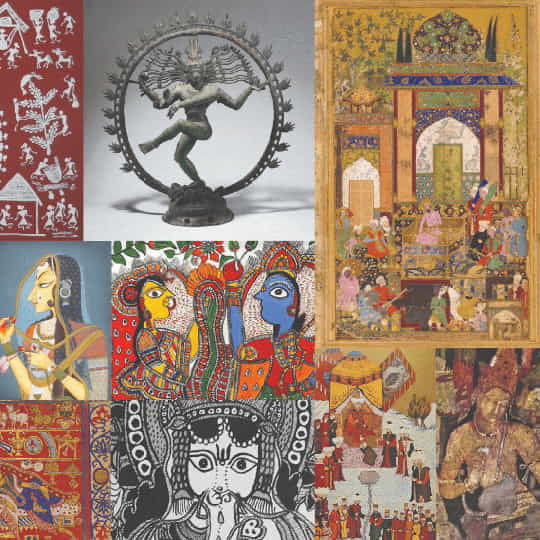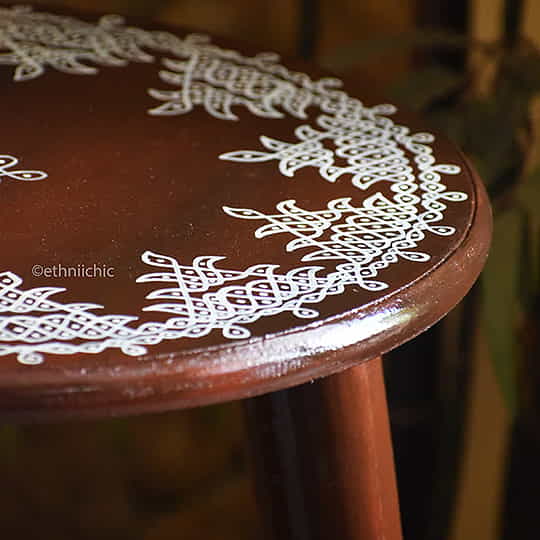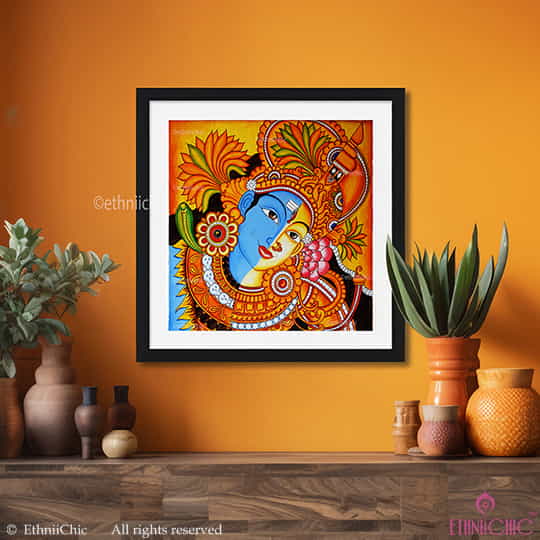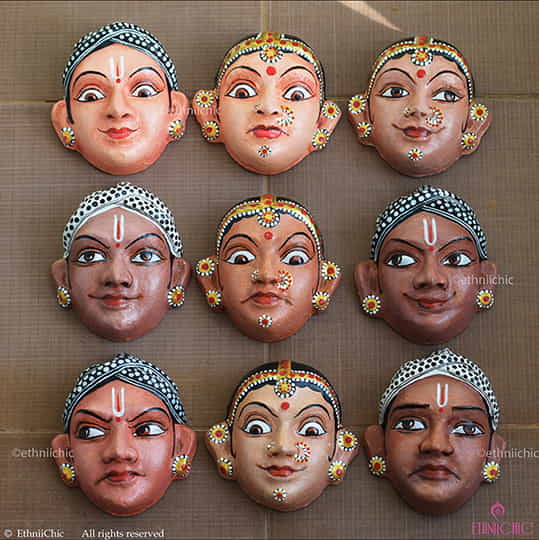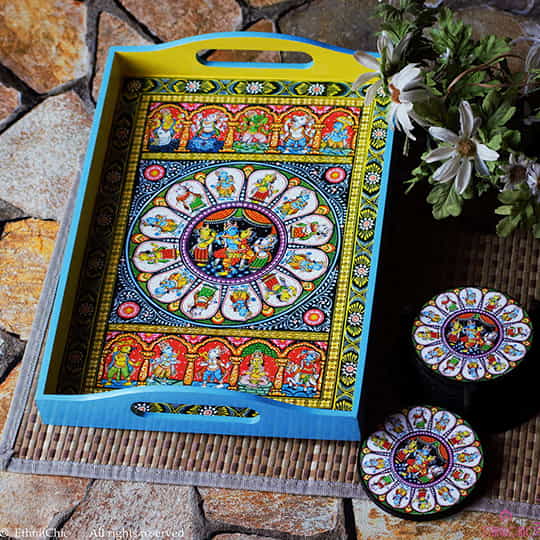The rain poured down heavily as Aanya stepped into the dimly lit antique shop in Jaipur. She had always been fascinated by the stories hidden in paintings, sculptures, and fabrics. Today, she was determined to explore the depths of India’s artistic heritage. As she walked in, an elderly shopkeeper, Mr. Bhardwaj, welcomed her with a warm smile.
“You seem interested in art, young lady,” he said, adjusting his glasses. “India has a treasure trove of traditional art forms, each carrying centuries of history and craftsmanship. Let me take you on a journey through time.”
Aanya’s eyes sparkled with excitement as she took a seat on the intricately carved wooden bench, eager to listen.
The Dance of Colors: Indian Painting Traditions
“Let’s begin with paintings,” Mr. Bhardwaj started. “India has a diverse range of painting styles, each deeply rooted in its culture.”
He pulled out a beautifully framed Madhubani painting from Bihar. “See these intricate patterns and vibrant colors? This folk art, originating from the Mithila region, uses natural dyes and depicts mythological themes, daily life, and nature. Traditionally, it was created on mud walls before moving to paper and canvas.”
Next, he unrolled a Pattachitra painting from Odisha and West Bengal. “These are storytelling paintings on cloth or palm leaves. The word ‘Pattachitra’ comes from ‘Patta’ meaning cloth and ‘Chitra’ meaning picture. These artworks often narrate stories from the Ramayana and Mahabharata.”
Aanya marveled at the fine details before moving to a Kangra painting from Himachal Pradesh. “Ah, this is a part of the Pahari school of painting. It flourished in the 17th century and is known for its delicate brushwork and romantic depictions of Radha and Krishna.”
The Art of Hands: Indian Sculpture and Carvings
Mr. Bhardwaj led Aanya to a section displaying beautifully sculpted idols. “India’s love affair with sculpture goes back to the Indus Valley Civilization. The famous ‘Dancing Girl’ and ‘Priest-King’ figurines are over 4,500 years old.”
He pointed to a brass statue of Lord Shiva as Nataraja. “This is from the Chola dynasty. The South Indian temples of Tamil Nadu, like Brihadeshwara Temple, showcase some of the finest Dravidian sculptures.”
Aanya noticed an elaborate sandstone carving. “This must be from Khajuraho, right?” she guessed.
Mr. Bhardwaj nodded, impressed. “Yes! The Khajuraho temples in Madhya Pradesh are famous for their intricate and sensuous sculptures, a fine example of Nagara-style temple architecture.”
Thread by Thread: Indian Textile Traditions
Moving towards a display of fabrics, Mr. Bhardwaj continued, “India is known for its textile heritage, and each region has a unique handloom tradition.”
He picked up a golden-bordered saree. “This is a Kanjeevaram saree from Tamil Nadu, woven with pure silk and zari work. It’s a symbol of grace.”
Then, he held up a lighter, more pastel-hued fabric. “And this is Chikankari embroidery from Lucknow, an ancient Persian-inspired embroidery that flourished under the Mughals.”
Aanya ran her fingers over a piece of fabric with intricate geometric patterns. “Is this Bandhani?”
“Yes! Bandhani is a tie-dye textile from Gujarat and Rajasthan. The craft dates back to the Indus Valley Civilization and involves plucking the fabric into tiny bindings before dyeing.”
He then showcased a Pashmina shawl from Kashmir. “Handwoven from the finest wool of the Changthangi goat, it takes months to create one. No machine can replicate the craftsmanship of these weavers.”
The Sound of Tradition: Indian Musical Instruments
The shopkeeper then led Aanya to a corner adorned with traditional Indian musical instruments. “Music and art are intertwined. Every classical Indian music performance features instruments deeply embedded in tradition.”
He picked up a Veena, its wooden body adorned with carvings. “This is one of the oldest string instruments in India, associated with Goddess Saraswati.”
Aanya recognized the Tabla. “This is used in Hindustani classical music, right?”
“Exactly,” Mr. Bhardwaj replied. “The Tabla, along with the Mridangam of Carnatic music, brings rhythm to our compositions. And this here,” he gestured toward a bowed instrument, “is the Sarangi, famous for its soulful melodies.”
The Stage of Expression: Indian Dance Forms
As they walked toward a section displaying traditional dance attire and props, Mr. Bhardwaj said, “Dance in India is more than performance; it’s devotion, storytelling, and discipline.”
He pointed to a brass figurine of a dancer. “This represents Bharatanatyam, the oldest classical dance form from Tamil Nadu, originally performed in temples. Each gesture, or ‘mudra,’ tells a story.”
Next, he showcased an ornate headpiece. “This belongs to Kathakali from Kerala. Unlike Bharatanatyam’s subtlety, Kathakali is theatrical, with elaborate makeup, dramatic expressions, and larger-than-life storytelling.”
Aanya noticed ankle bells nearby. “These must belong to Kathak dancers.”
“Indeed,” Mr. Bhardwaj said. “Kathak originated in North India, influenced by Persian and Mughal elements, blending storytelling with rhythmic footwork.”
They continued discussing other classical and folk dances like Odissi, Manipuri, Kuchipudi, and Bhangra, each carrying the soul of its region.
Echoes of the Past: Indian Pottery and Metal Crafts
Moving toward shelves lined with terracotta and metal artifacts, Mr. Bhardwaj said, “Pottery is one of India’s oldest crafts. The Indus Valley Civilization was known for its terracotta figurines and painted pottery.”
He handed Aanya a Blue Pottery bowl from Jaipur. “Unlike other pottery forms, this doesn’t use clay but a unique mix of quartz and glass.”
Then he picked up a Dhokra metal craft figurine. “This is a lost-wax technique from Chhattisgarh and Odisha, dating back 4,000 years.”
Aanya admired the golden artwork. “What about Bidriware?” she asked.
“Ah! You know your art,” he said, smiling. “Bidriware from Karnataka is a metal craft with silver inlay work, introduced during the Bahmani Sultanate.”
The Final Stroke: Preserving Tradition in a Modern World
As the evening settled in, Aanya realized how vast and rich India’s artistic heritage was. “Mr. Bhardwaj, with modernization, are these art forms at risk of fading?”
He sighed. “Some indeed are. The younger generations are moving towards digital mediums, and many artisans struggle. But initiatives are in place—government schemes, online marketplaces, and global recognition are helping keep these traditions alive.”
Aanya smiled, feeling inspired. “I want to do my part. Maybe I can document and promote these crafts through storytelling.”
Mr. Bhardwaj nodded, “That’s how traditions survive—by passing down stories, just like I did today.”
As she stepped out into the now-clear night sky, Aanya felt she had taken a journey not just through an art shop but through the heart of India itself. And with that, she carried forward the legacy of art, ensuring that these traditions found their place in the modern world.
India’s traditional art forms are not just remnants of the past; they are living, breathing expressions of its cultural soul. Each stroke, carving, and weave carries the spirit of generations. Whether through storytelling, dance, music, or fabric, these arts continue to inspire and connect us to our roots. Let us cherish and support them, for in their survival lies the story of India itself.


